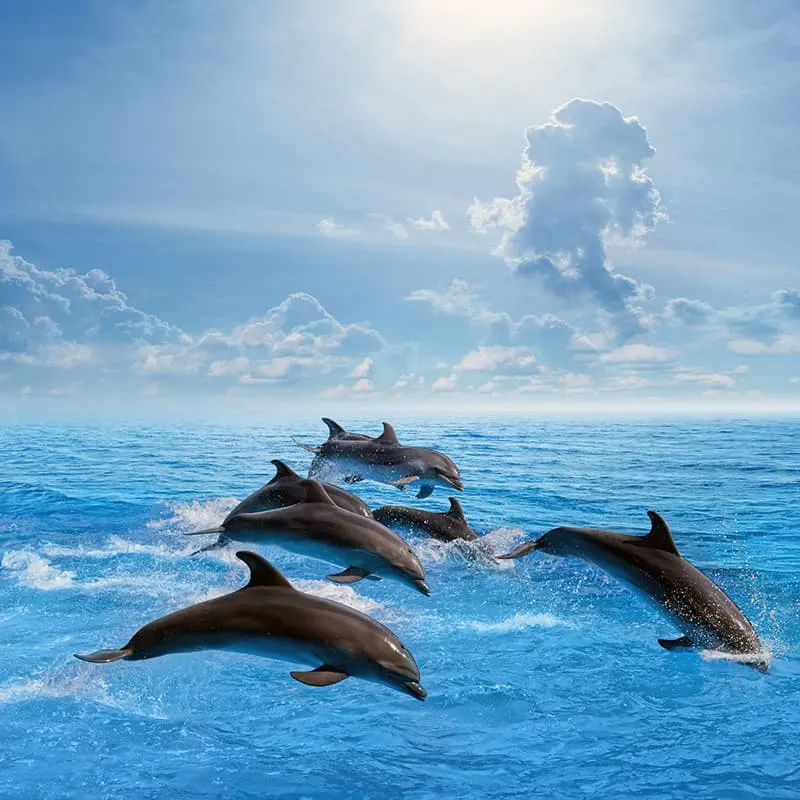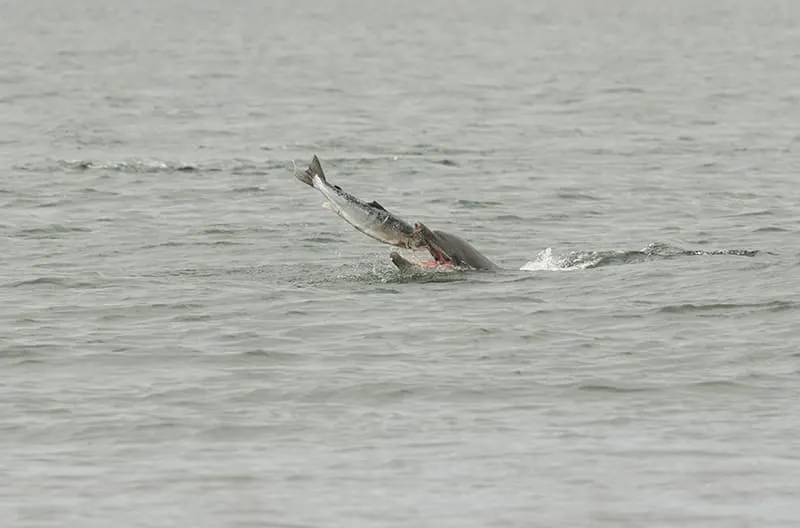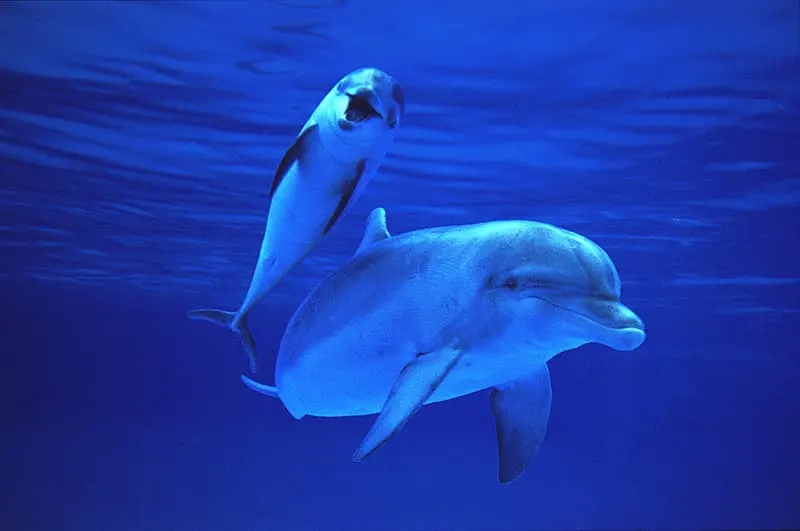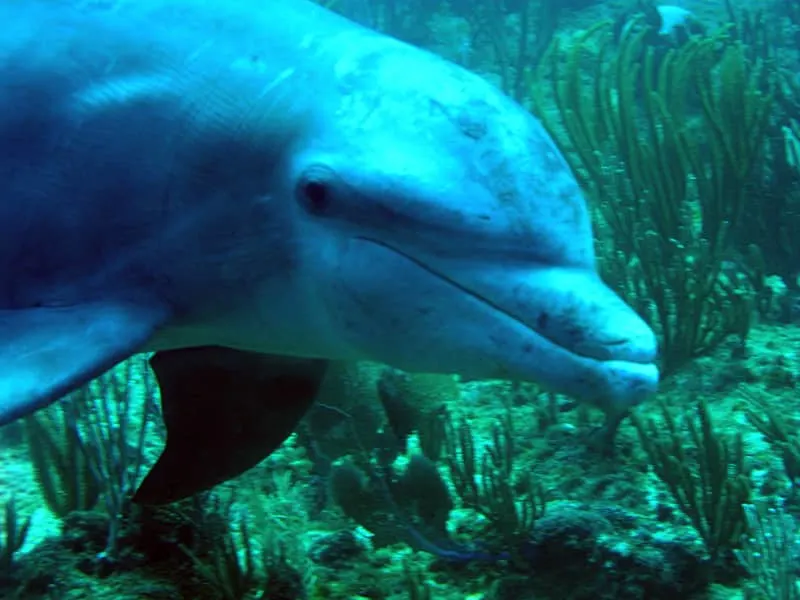Want to learn some bottlenose dolphin facts for kids? You’ll find them in this post. We’ll talk about their physical description, diet, offspring, and more! Read on to learn more about these fascinating ocean mammals.

There are two species of bottlenose dolphins. The species are the common bottlenose dolphin and the Indo-Pacific bottlenose dolphin. This article will discuss the common bottlenose dolphin.
Learn more about the Indo-Pacific bottlenose dolphin.
Physical Description
Common bottlenose dolphins have streamlined, torpedo-shaped bodies. They are dark blue-gray in color. The color starts out darker on the top of the body, then graduates to a lighter hue. Bottlenose dolphins have white bellies.
Their thick, smooth skin looks and feels rubbery. Bottlenose dolphins are famous for their long jaws and curved mouths. This makes it look like they are smiling.
Common bottlenose dolphins have short, pointed teeth that are uniform in size. They have short, thick snouts.
These dolphins have a pair of pointed, paddle-like flippers that are located on each side of their bodies. A bottlenose dolphin has a dorsal fin located at the center of its back. The tail is shaped like a “Y” with two parts called “flukes”.
Common bottlenose dolphins grow to be between six and thirteen feet long. Adults weigh anywhere from three hundred to fourteen hundred pounds. The average weight of a common bottlenose dolphin is about four hundred pounds.
The length and weight of common bottlenose dolphins vary with geographic location and the water temperature of their habitat. The colder the water is, the larger the bottlenose dolphin is.
Habitat
Bottlenose dolphins live in the temperate and tropical waters of the Pacific and Atlantic Oceans. They are also found in the Mediterranean and Black Seas. These dolphins are found in both shallow and deeper ocean waters.
They can be found in coastal waters, bays, inlets, rivers, and other waterways near the shore. Common bottlenose dolphins tend to avoid the colder waters of the Arctic and Antarctic.
Some common bottlenose dolphins have a home range. A resident dolphin community near Florida has a home range of about forty-five miles.
When there are seasonal changes, a group of Atlantic bottlenose dolphins migrates between New Jersey and North Carolina. Scientists think that some dolphin groups migrate for warmer waters or to follow a food source.

Habits
Common bottlenose dolphins are active during the day and night. They are social creatures and spend their time in groups called “pods.” They don't stay in one pod. Pods have a dynamic membership.
Dolphins will go to different pods depending on their needs. There is a social hierarchy in these groups. Pod sizes can be as small as two dolphins or as many as thirty dolphins. Staying in pods also helps dolphins defend themselves against predators.
Dolphins spend their time socializing, eating, traveling, and resting. They can travel up to eighty miles a day if they find plenty of food to eat along the way.
Common bottlenose dolphins also like to play. They enjoy jumping in the water and swimming in the waves boats make. They also play-fight and chase each other. Common bottlenose dolphins have been seen playing with seaweed and fish. They will pass these to other members of their pod using their snouts, flippers, and tails.
Sleep
Bottlenose dolphins need eight hours of sleep a day, just like people do. Unlike humans, they control their breathing. Bottlenose dolphins don’t go into a deep sleep because they don’t breathe automatically. One half of their brains go to sleep at a time. Each side of the brain goes to sleep while the other side stays awake. They also keep one eye open while the other eye is closed. This is how they keep an eye out for predators.
Breathing
Common bottlenose dolphins need to breathe air into their lungs. They control their breathing. They don't breathe automatically like people do. They also don’t breathe through their snout. They breathe through the blowhole that is on top of their heads. A blowhole is like a big nostril. Dolphins can only breathe when their blowhole is exposed to the air. Common bottle-nosed dolphins can hold their breath underwater for about twelve minutes. If dolphins don't come up for air on a regular basis, they will drown.
Echolocation
Dolphins use echolocation to find prey. Echolocation is a type of natural sonar system. Bottlenose dolphins make a sequence of clicks. The clicks pass through the dolphin’s “melon.” This organ is in the dolphin’s forehead. The dolphin then hears the echo of the clicks when they bounce off an object. Echoes tell the dolphin how far away an object is, as well as its shape. It’s as if the dolphins “see sound”.
Communication
Common bottlenose dolphins are great communicators. They communicate through body language by using their flippers and tails. They can use their body language to tell other dolphins if they want to eat or play.
They also communicate by making whistles and squeaking sounds. Bottlenose dolphins don't have vocal cords. They make noises by using the air sacs that are located near their blowhole. Each dolphin has its own whistle. They use this as a way of identifying themselves.
People identify themselves by their first names. The same function is accomplished with a dolphin’s whistle. The main reason bottlenose dolphins use a variety of sounds is to alert each other to food and danger. There are at least thirty other sounds that dolphins make as part of their regular communication with each other. Dolphins make sounds both above and beneath the water.

Diet
The diet of a common bottlenose dolphin varies based on where it lives. They like to eat different kinds of fish, squid, and crustaceans. Coastal bottlenose dolphins eat fish and other marine creatures that live on the ocean bottom. Offshore bottlenose dolphins eat both fish that live in shallow and deep water, as well as squid. Dolphins have rapid digestion and eat up to 6% of their body weight each day.
Offspring
Common bottlenose dolphins have different mating seasons depending on where they live. Some of these dolphins breed throughout the year. Different dolphins in the pod breed with different males and females. Female bottlenose dolphins are pregnant for a year.
Mother dolphins often have help from a female or male dolphin buddy when they give birth. Common Bottlenose dolphin mothers give birth to one offspring at a time.
Dolphin babies are about 45 inches long when they are born. Babies are a darker gray than adults and weigh anywhere from twenty pounds to forty-four pounds. The baby’s fins and tail are soft when they are born but harden in a few days.
Baby bottlenose dolphins will nurse for about two years, for only a few seconds at a time. They start eating fish at about three months old, when their teeth come in. A bottlenose dolphin baby swims behind its mom and stays with its mom for three to six years.
Common bottlenose dolphins have special pods that are made up of mothers and their babies. As the baby matures, the mother and juvenile dolphin join other pods. The juvenile dolphin will join a pod with other juveniles. When it matures into an adult, it will join a pod with other adult bottlenose dolphins.

Classification/Taxonomy
Kingdom: Animalia
Phylum: Chordata
Class: Mammalia
Order: Cetacea
Family: Delphinidae
Genus: Tursiops
Species: Tursiops Truncatus
History
The ancestor of the dolphin is a hoofed mammal, not a marine one. This mammal appeared about thirty-five million years ago. The dolphin family, Delphinidae, appeared about twelve million years ago. Common bottlenose dolphins appeared two to five million years ago. It's thought that the common bottlenose dolphin took about 50 million years to change into what it is today.
People have known about common bottlenose dolphins for a very long time. Aristotle, an ancient Greek philosopher and scientist, wrote about bottlenose dolphins 2300 years ago. Dolphins were part of Greek mythology and art.
Predators
Common bottlenose dolphins’ main natural predators are sharks. Great white sharks, tiger sharks, sand sharks, and bull sharks are known for preying on bottlenose dolphins. Sometimes a pod of orcas will prey on common bottlenose dolphins as well.
The common bottlenose dolphin is listed as “Least Concern” on the IUCN Red List.
Lifespan
The typical lifespan of a dolphin in the wild is between thirty and fifty years old. Common bottlenose dolphins living in captivity typically have a shorter lifespan than dolphins in the wild. They live for an average of twelve to twenty-two years in captivity.

What Sound Does a Bottlenose Dolphin Make?
Click on this audio file to hear what a bottlenose dolphin sounds like.
25+ Unusual Facts
- The two flippers on a bottlenose dolphin's tail are called “flukes.”
- Bottlenose dolphins have between 75 and 105 teeth.
- A bottlenose dolphin can swim a long distance while half of its brain sleeps.
- Sometimes a dolphin shows off by blowing water out of its blowhole in a dramatic way.
- The horseshoe-shaped pupils of bottlenose dolphins allow them to see clearly in both air and water.
- Common bottlenose dolphins have a poor sense of smell.
- Scientists have not found any evidence that dolphins have a language. (rewrite)
- Common bottlenose dolphins in captivity play more than those in the wild.
- Common bottlenose dolphins play games like “tag” and “keep-away”.
- Bottlenose dolphins can plan and solve problems.
- Common bottlenose dolphins can recognize themselves in a mirror at 7 months old.
- Dolphins have the longest memories of all mammals except humans.
- Dolphins have different personalities and can experience grief.
- Some people believe common bottlenose dolphins are only slightly less intelligent than humans.
- Bottlenose dolphins are trained for wartime tasks by the United States and Russian militaries.
- Bottlenose dolphins help injured pod mates by supporting them so they can breathe.
- The common bottlenose dolphin is sometimes called the Atlantic or Pacific bottlenose dolphin.
- Male bottlenose dolphins are known for forming lifelong bond-pair friendships.
- Male dolphins are called bulls, females are called cows, and babies are called calves.
- “Nursery pods” of common bottlenose dolphins consist of mothers and their calves.
- Bottlenose dolphins have “teenager pods,” which are made up entirely of juvenile dolphins.
- Common bottlenose dolphins have a cruising speed of 3.5 miles per hour.
- The fastest a bottlenose dolphin can swim is 18 miles an hour for a short distance.
- Dolphins shed their top layer of skin every two hours to keep their bodies smooth for swimming.
- Common bottlenose dolphins can hear better than people.
- Depending on where they live, some bottlenose dolphins dive deeper than others.
- Common bottlenose dolphins don’t chew with their teeth. They swallow their food whole.
- Female bottlenose dolphins give birth every 3 to 6 years.
- The oldest dolphin ever discovered in the wild was 67 years old.
- The oldest dolphin in captivity reached the age of 61.
- Female common bottlenose dolphins become adults between 5 and 7 years old.
- Male common bottlenose dolphins become adults between 10 and 12 years old.
- Common bottlenose dolphins can jump up to 20 feet and land on their backs, bellies, or sides.
- Dolphins, like humans, maintain a steady body temperature.
- Dolphins are at risk from fishing gear because they become entangled in it or they eat it.
- There are about 600,000 common bottlenose dolphins in the world.
- Common bottlenose dolphins can remember each other for at least 20 years.
- Dolphins fight for a spot in the pod, for females, and for small squabbles.
We hope you enjoyed learning all about common bottlenose dolphins! Did you learn anything new? Let us know what other facts you know about them. We can’t wait to hear more.
Check out these other cool mammals!
